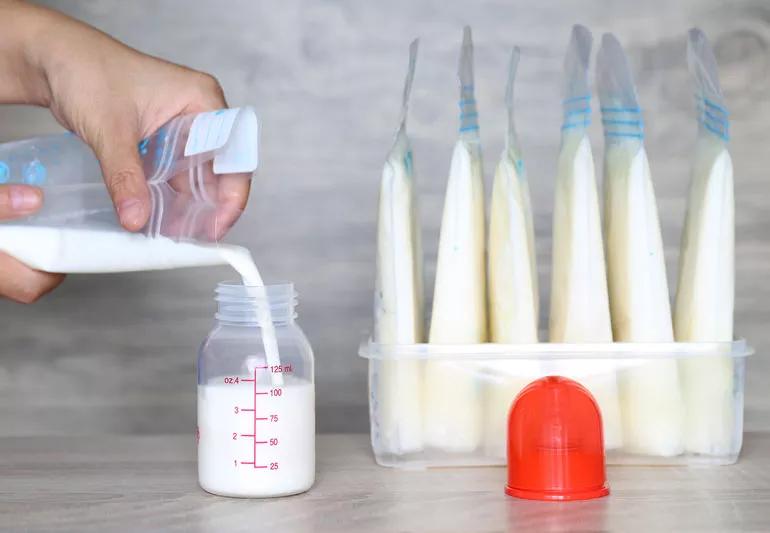Typically, you’ll want to store 2 to 4 ounces at a time

The old adage says there’s no use crying over spilled milk. But when it’s milk for your little one, it’s sad to see any go to waste.
Advertisement
Cleveland Clinic is a non-profit academic medical center. Advertising on our site helps support our mission. We do not endorse non-Cleveland Clinic products or services. Policy
With proper planning, you can prevent wasting any breast milk (chest milk) you’ve pumped to nourish your baby or toddler. And if you’re getting your supply from a breast milk donor bank, knowing how to store milk is key to making sure your little one is fed.
So, how long will it keep in the fridge or freezer? What containers should you store it in? And what’s the best way to thaw it? Pediatrician and breastfeeding medicine specialist Heidi Szugye, DO, IBCLC, explains all the reasons you may want to store breast milk, along with tips for making sure it’s good enough for your child.
If you’re hand-expressing your breast milk or pumping, it’s good to know how to store the milk you produce. Storing your milk allows you to have some ready for whenever your child has their next feeding. Plus, it’s important to know how to store your milk so it stays fresh and maintains its nutritional properties and immune-system boosters.
Even after you’ve used up your colostrum during your earliest feedings, human milk is as beneficial as formula when it comes to nutritional value, especially during your infant’s first six months of life. And if you’re unable to produce breast milk on your own, human milk banks are a helpful resource that collects, screens, stores, processes and distributes milk for parents in need.
Advertisement
Breast milk can be kept at room temperature, in a refrigerator or in a freezer — and how long you can store your milk safely depends on its location and the containers you use.
In most cases, you’ll want to store 2 to 4 ounces of breast milk at a time. On average, this is the amount of milk that your baby consumes in a single feeding. Storing a smaller amount of 1 to 2 ounces can also be helpful for when you need to provide a smaller snack or for babies fewer than 6 weeks old.
Containers you can use to store milk include:
When storing milk, it’s important to label each container with a smudge-proof marker with the date expressed and the amount of milk in each container. Use the oldest milk first to keep your supplies fresh and avoid expired or sour milk. If you’re delivering stored milk to childcare, you should also label the container with your child’s name to avoid mix-ups.
Storing smaller amounts can be useful, as they can be warmed quickly and may help cut down in the amount you throw away. This is particularly important when it comes to milk that you’ve frozen and then thawed: Thawed or warmed milk has a much shorter shelf life than when it’s refrigerated. So, once you remove it from a cool environment, the clock starts ticking.
Milk can be stored:
You want to avoid storing milk in the door of your refrigerator or freezer and store it at the back instead to avoid frequent temperature changes. The other thing to consider while freezing is that sometimes your milk may look differently than you expect.
Advertisement
It’s normal for stored milk to separate into a cream and milk layer. It’s also normal for breast milk to appear in a range of colors from slightly yellow to yellow-orange and even green. The color of your breast milk can change based on what you eat, drink and the medications you take while breastfeeding. If you’re ever concerned about the color of your stored milk, a lactation consultant can offer some direction on what’s safe to use.
The amount of time you can keep breast milk out at room temperature depends on how warm the surrounding environment is and whether or not the milk is freshly expressed or if it’s been previously frozen and then thawed and/or warmed for feeding.
At room temperature (77 degrees Fahrenheit, 25 degrees Celsius), breast milk should be used:
You never want to keep milk at temperatures higher than 77 F (25 C) because of the risk of bacteria growth. Once your milk has been frozen and thawed, you also never want to refreeze your milk.
“To be safe, discard any previously frozen milk that’s been heated and served to your baby after one to two hours,” advises Dr. Szugye. “Refreezing milk can lead to contamination, so you never want to refreeze milk that’s been thawed.”
Advertisement
A child can drink cold or room-temperature milk, but they may like it better if it’s warm. When warming milk, you never want to use a microwave or directly use a stovetop or oven. A microwave doesn’t heat breast milk evenly, and if the milk is too hot, it can scald your baby. Heating milk too quickly or at higher temperatures can also destroy important proteins and vitamins in the milk. In some cases, it can also cause the bottle to explode if it’s heated for too long. Also, never bring your milk to a high heat or boiling point.
To thaw and warm frozen breast milk, start by holding the container of frozen milk under warm, running water for a few minutes. You can also heat a pan of water on the stove over low-to-medium heat, remove it from the stove after a minute or two, and then soak your freezer bag in the pan of warm water for several minutes.
When soaking, you’ll want to make sure the water doesn’t go over the top of the bag or make contact with the seal in order to avoid contamination. If your milk looks cloudy while warming, there’s been a leak and the milk is no longer good.
You can also use a bottle warmer if you have one.
Once the milk has been warmed, swirl the separated cream and milk layers together. Test the milk’s temperature by putting a few drops of milk on your wrist — if it feels slightly warm but not hot, it’s safe to use for feeding.
Advertisement
If your child doesn’t finish the entire container, you can use the leftover milk within two hours of warming. After two hours, you should discard any leftover, previously thawed milk.
“Breast milk has many nutrients tailored to your baby’s growing needs,” says Dr. Szugye. “With a little planning, you can continue providing for your baby throughout their infancy.”
Learn more about our editorial process.
Advertisement

Hand-expression can be used in a variety of scenarios

It’s highly unlikely your baby will have an allergic reaction to food you eat

Breastfeeding supplements can be a needless expense at best, and risky at worst

Not all rainbows have gold at the end — the ones our bodies produce offer insight into our health

And how to wean them off formula when it’s time

Type 2 diabetes isn’t inevitable with these dietary changes

Applying a hot or cold compress can help with pain